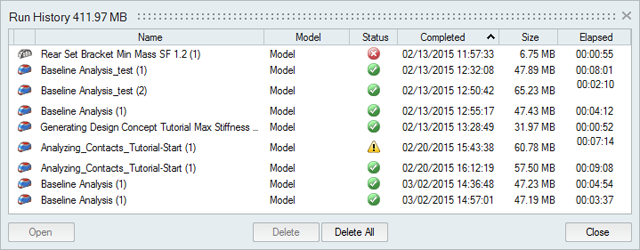Run Thinning Analysis
Use to run a quick thinning analysis when designing sheet metal parts that are thinned from flat blanks. Then interactively view the results using the Analysis Explorer.
-
Click the Run Thinning Analysis
 button on the Thinning
icon.
button on the Thinning
icon.

The Run Analysis window opens. - Click Run. Use the Run Status window to monitor the progress of the run.
-
When the run completes, click the green flag on the
Thinning icon or double-click the name of the run in
the Run Status window to view the results.

- A thinning analysis can only be performed on a midsurface, not solid geometry. If CAD data for the midsurface is not directly available, use the Midsurface tool in Inspire to extract one.
- Material properties are assigned using the Materials tool on the Structure ribbon or the part context menu. The casting add-on only supports Inspire materials. For user-defined materials created in Inspire, the add-on creates a thinning equivalent by using the yield stress and changing the strength coefficient, but does not change the strain hardening and anisotropy values.
- Thickness can be defined using the Property Editor, accessed by pressing F3.
Run Status
View the status of the current run, as well runs for the current model that have not yet been viewed. To see all past runs, you need to view the run history.
-
Hover over the Analyze icon, then select the
Run Status tool.

Tip: To find and open a tool, press Ctrl+F. For more information, see Find and Search for Tools.The run status window is displayed.
-
When the run is complete, review its status.
Status Description Note 
The run completed successfully. This is also indicated by a green flag above the Analyze icon. You can click the green flag to display the results. 
The run was incomplete. If running an analysis, the run was incomplete. Some but not all of the result types may be available. You should run a new analysis to generate complete results.
If running an optimization, the run was completed but with warnings or violations. Double-click the name of the run in the Run Status dialog, and then click the Design Violations button in the Shape Explorer for more information.

The run failed and no meaningful results are available. This is also indicated by a red flag above the Analyze icon. -
View one or more runs.
- To view a run, double-click the row.
- To view multiple runs, hold down Ctrl or
Shift while clicking the rows, and then click
the View Now button.Note: If several runs are associated with the same part, the result from the most recently completed run for that part will be activated in the modeling window.
- To open the directory where a run is stored, right-click the run name and select Open Run Folder.
- To view deleted or previously viewed runs, click the History button.
- To delete a run, select the run and press Delete. You can also delete runs using the right-click context menu in the Analysis Explorer and the Model Browser.
Run History
View, sort, open, and delete past runs for the current and previous models.
-
Hover over the Analyze or Analyze
Fluids icon, then select the Run
Status tool.

Tip: To find and open a tool, press Ctrl+F. For more information, see Find and Search for Tools.The run history is displayed.
-
Review the status of the run.
Status Description Note 
The run completed successfully. 
The run was incomplete. If running an analysis, the run was incomplete. Some but not all of the result types may be available. You should run a new analysis to generate complete results.
If running an optimization, the run was completed but with warnings or violations. Double-click the name of the run in the Run Status dialog, and then click the Design Violations button in the Shape Explorer for more information.

The run failed and no meaningful results are available. - To view a run, double-click the row.
- To open the directory where a run is stored, right-click the run name and select Open Run Folder. The default directory where the run history is stored can be changed in the Preferences under Run Options.
- By default, you will receive a notification when the run history exceeds a certain size. You can change the size limit or turn off the notification in the Preferences under Run Options.
- To delete a run, select the run and press Delete.